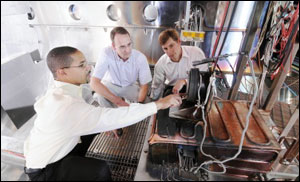
Air Force Funds Study of Plasma-Wall Interactions
The US Air Force Office of Scientific Research (AFOSR) has awarded the Georgia Institute of Technology and the University of Alabama a $2.5 million grant for a five-year plasma-wall research program that could lead to improvements in high-intensity lamps, new plasma deposition, spray coating processes, high-performance satellite thrusters, and radar and communications systems.
The researchers will use a new terahertz-frequency laser analysis technique that will allow for noninvasive studying of the plasma sheath, the portion of the plasmas that interacts with the wall. They will use atomic probe technology to study how the plasmas — a state of matter that contains ionized particles — interact with and are affected by the walls.
Plasmas are created when electrons are added to or removed from atoms, giving them a charge. The interaction between the resulting ionized gas and the wall can be complex, involving the transfer of mass, charge and energy from the plasma to the wall, and sometimes from the wall back to the plasma. This energetic interaction may damage the wall, eroding the surfaces and leading to device failure.
Existing plasma wall materials have been developed largely by trial and error. Developing a fundamental understanding of the plasma-wall interaction will provide researchers with the information they need to develop better wall materials.

Researchers Mitchell Walker, Gregory Thompson and Georgia Tech principal research engineer Jud Ready examine a Hall Effect thruster. The thruster, used in satellites, will be among the applications to benefit from the fundamental research on plasmas. (Image: Gary Meek, Georgia Tech)
“In these systems, the plasma is dumping energy into the wall, and the wall may be giving back some particles or energy that affect the plasma,” said Mitchell Walker, associate professor in the Georgia Tech School of Aerospace Engineering. “There is a dance between the plasma and the wall that needs to be understood so we can improve the materials across a range of applications.”
A terahertz-frequency laser is used to study the narrow portion of the plasma (the sheath), where the wall interaction takes place. It is there, in that small region that is only a fraction of a millimeter wide, that plasma particles collide with the wall, transfer electrical charge and apply energy.
“The sheath has a strong electric field which is either pulling or pushing electrons from it,” Walker said. “By adjusting what the wall material contains, we can change the sheath and watch how the plasma adjusts to the wall.”
Traditional probe techniques used for studying such phenomena alter the sheath activity when they penetrate it, so the researchers used the terahertz laser technique because it does not physically enter the plasma, enabling them to measure the sheath without affecting the plasma. To give the laser a larger target for study, Walker will produce plasma sheaths as much as a centimeter wide.
“This will allow us to make measurements that nobody has ever done before,” he said. “Using the data we obtain, we will be able to look at all of the analytical models that people have generated and compare them to real experimental data.”
The researchers say they will use unique tools from the University of Alabama to identify individual plasma atoms that may be embedded in the walls, helping them to better understand how a broad range of materials would interact with the plasmas. Then, they “will systematically characterize how plasmas interact and contribute to the underlying phase and mechanical stability characteristics in the materials,” said Gregory Thompson, associate professor in the Department of Metallurgical and Materials Engineering at the University of Alabama.
Finally, the team will apply its experience with thin-film deposition and phosphors to create an additional analytical tool. By embedding certain phosphors in the walls, the investigators will be able to tell how much energy is being transferred — and where that is occurring.
For more information, visit: www.gatech.edu
Published: September 2011